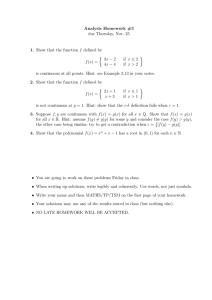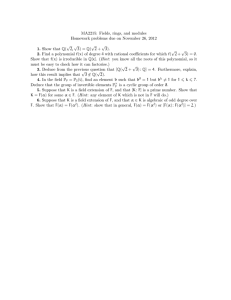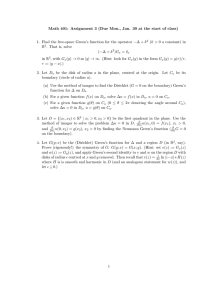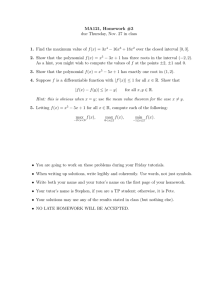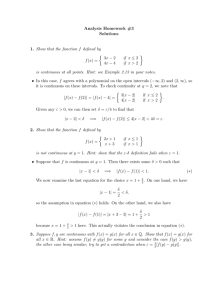≥ ∈ N
advertisement
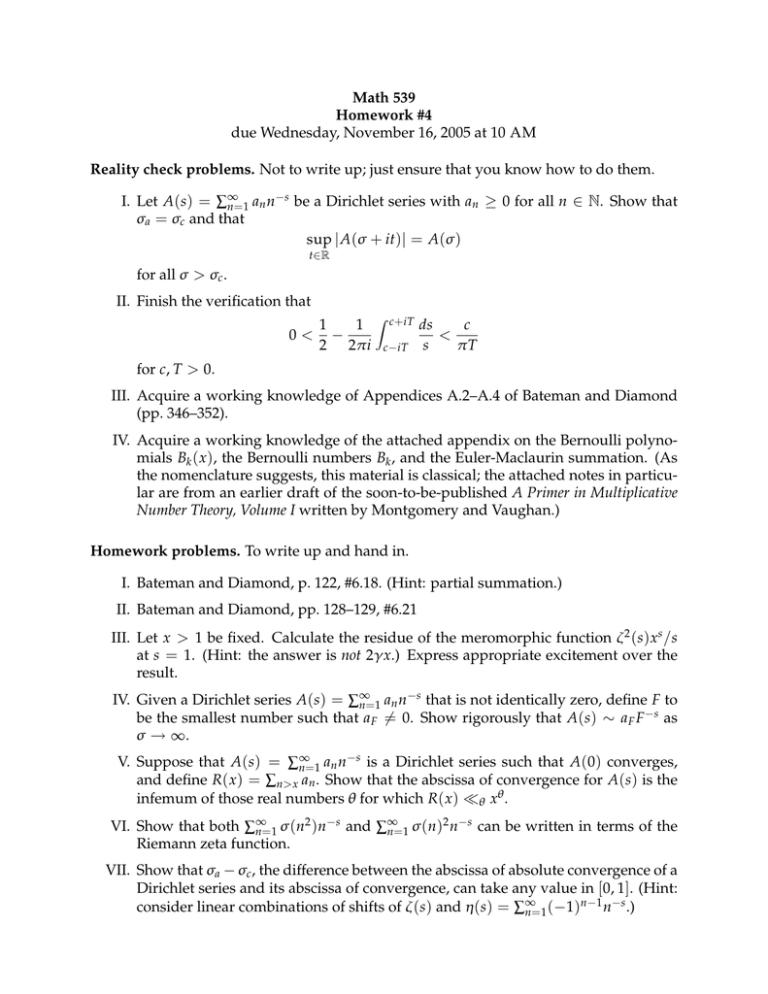
Math 539
Homework #4
due Wednesday, November 16, 2005 at 10 AM
Reality check problems. Not to write up; just ensure that you know how to do them.
−s be a Dirichlet series with a ≥ 0 for all n ∈ N. Show that
I. Let A(s) = ∑∞
n
n=1 an n
σ a = σc and that
sup | A(σ + it)| = A(σ )
t∈R
for all σ > σc .
II. Finish the verification that
1
1
0< −
2 2πi
Z c+iT
ds
c−iT
s
<
c
πT
for c, T > 0.
III. Acquire a working knowledge of Appendices A.2–A.4 of Bateman and Diamond
(pp. 346–352).
IV. Acquire a working knowledge of the attached appendix on the Bernoulli polynomials Bk ( x), the Bernoulli numbers Bk , and the Euler-Maclaurin summation. (As
the nomenclature suggests, this material is classical; the attached notes in particular are from an earlier draft of the soon-to-be-published A Primer in Multiplicative
Number Theory, Volume I written by Montgomery and Vaughan.)
Homework problems. To write up and hand in.
I. Bateman and Diamond, p. 122, #6.18. (Hint: partial summation.)
II. Bateman and Diamond, pp. 128–129, #6.21
III. Let x > 1 be fixed. Calculate the residue of the meromorphic function ζ 2 (s) xs /s
at s = 1. (Hint: the answer is not 2γx.) Express appropriate excitement over the
result.
−s that is not identically zero, define F to
IV. Given a Dirichlet series A(s) = ∑∞
n=1 an n
be the smallest number such that a F 6= 0. Show rigorously that A(s) ∼ a F F −s as
σ → ∞.
−s is a Dirichlet series such that A (0 ) converges,
V. Suppose that A(s) = ∑∞
n=1 an n
and define R( x) = ∑n>x an . Show that the abscissa of convergence for A(s) is the
infemum of those real numbers θ for which R( x) θ xθ .
2 −s and ∞ σ ( n )2 n−s can be written in terms of the
VI. Show that both ∑∞
∑n=1
n=1 σ ( n ) n
Riemann zeta function.
VII. Show that σ a − σc , the difference between the abscissa of absolute convergence of a
Dirichlet series and its abscissa of convergence, can take any value in [0, 1]. (Hint:
n−1 n−s .)
consider linear combinations of shifts of ζ (s) and η(s) = ∑∞
n=1 (−1 )
D EFINITION . An arithmetic function f is of polynomial growth if there are positive
constants C, d such that | f (n)| ≤ Cnd for all n ∈ N.
VIII. Recall Theorem 2.7: any arithmetic function h with h(1) 6= 0 has a convolution
inverse h−1 satisfying h ∗ h−1 = e.
(a) Suppose that g is an arithmetic function satisfying g(1) = 1 and | g(n)| ≤ 1
for all n ∈ N. Prove that | g−1 (n)| ≤ n2 for all n ∈ N. (Hint: use g ∗ g−1 = e to
bound g−1 (n) recursively.)
(b) If f is an arithmetic function of polynomial growth with f (1) 6= 0, prove that
f −1 is also of polynomial growth.
(c) Suppose that A(s) is a Dirichlet series that converges in some right half-plane.
Show that 1/ A(s) is represented by a Dirichlet series that converges in some
right half-plane if and only if limσ →∞ A(s) 6= 0.
IX. Given k ∈ N, define Ωk (n) to be the total number of prime factors of n (with
multiplicity), but only counting primes that are larger than k:
Ωk (n) =
∑
r
r.
p kn
p>k
Ωk (n) n−s . Prove that E ( s ) = ζ k ( s ) F ( s ), where F is a Dirichlet
Let Ek (s) = ∑∞
k
k
k
n=1 k
series that converges for σ > 21 . Conclude that
−1 k
1
k
k
1−
.
lim (s − 1) Ek (s) = Fk (1) = ∏ 1 −
p
p
s→1
p>k
What goes wrong if we replace Ωk (n) with Ω(n)? Why should we expect this?
How does the limit change if we replace Ωk (n) by ω(n) in the definition of Ek ?
X. (a) Let N and K be any positive integers. Show that for σ > 1,
Z ∞
K N 1−s
s+k−2
Bk
s+K−1
−s
−s
ζ (s) = ∑ n +
+N ∑
−
BK ({ x}) x−s−K dx,
k −1
s
−
1
k
−
1
K
kN
N
n≤ N
k=1
where Bk is the kth Bernoulli number, BK is the Kth Bernoulli polynomial, and
for any complex number z and positive integer m the binomial coefficient (mz )
is defined to be the polynomial value (mz ) = z( z − 1) . . . ( z − m + 1)/m!. (Hint:
use Euler-Maclaurin summation on the sum ∑n> N n−s .)
(b) Show that ζ (s) can be analytically continued to a meromorphic function on
the entire complex plane, with its only pole a simple pole at s = 1. (Hint:
you don’t have to get the entire complex plane in one go—bigger and bigger
pieces of it will suffice.)
(c) Compute the value of ζ (n) on every nonpositive integer n. (Hint: take N = 1
and s = 2 − K in the equation from part (a). Setting x = −1 in equations (5)
and (15) of the attached appendix will also provide useful information.)
Bonus problem: Using problem X(a) or otherwise, calculate ζ 0 (0) in closed form.
